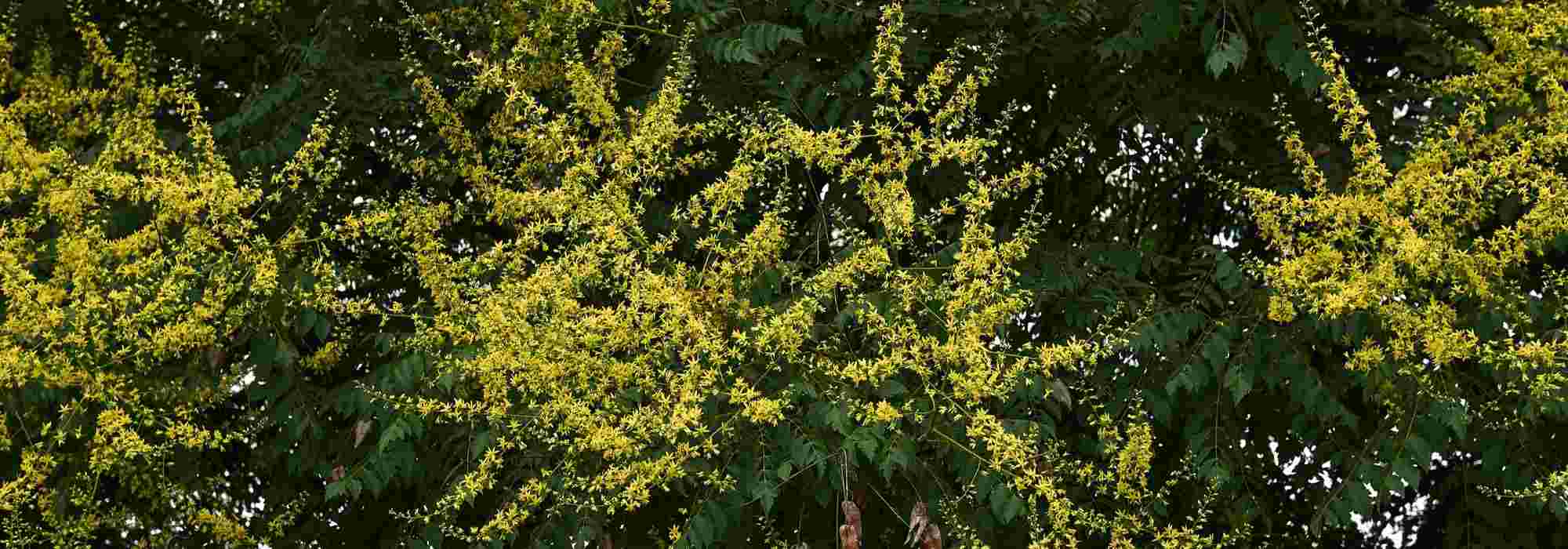
Pride of India, Koelreuteria: planting, care
Contents
Pride of India in a nutshell
- The Pride of India is one of those spectacular small trees from spring to autumn
- Its finely dissected bright green foliage turns to gold by the end of summer
- Its yellow summer flowering is followed by curious lantern-shaped colourful fruits
- It is perfectly hardy and easy to grow in full sun, in ordinary soil, even calcareous
- It is a medium-sized tree that is simply sumptuous in any garden, whether in a border or as a specimen
A word from our expert
The Pride of India is a small tree or large bush, reaching heights of 6-8 m, notable for its changing foliage, its summer flowering of sun-yellow blooms, and its lantern-shaped fruits that turn brown and dry at the end of the season.
Koelreuteria paniculata and its cultivars, such as ‘Coral Sun’, are the most common species found in our gardens.
It is an elegant and unobtrusive tree that fits well in any garden. Hardy and low-maintenance, it is easy to grow in ordinary soil, even calcareous.
Stunning when planted alone or in a strategic spot in the garden to enjoy its unique summer flowering, near a wall or as a street tree, discover the Pride of India, this exotic-looking tree that breaks the monotony of classic foliage.
Description and botany
Botanical data
- Latin name Koelreuteria
- Family Sapindaceae
- Common name Pride of India, golden raintree
- Flowering June-July
- Height 5 to 10 m
- Exposure Sun
- Soil type All, well-drained
- Hardiness -15°C
Koelreuteria, or Pride of India, also known as “Golden raintree” is a small tree or large bush from the Sapindaceae family, or “soap plants” that contain saponin. It is native to the dry, wooded valleys of China and Korea. The genus includes only three species. In our gardens, we mainly encounter the species Koelreuteria paniculata, which has given rise to numerous cultivars, such as ‘Coral Sun’ and hybrids like Koelreuteria paniculata var. Apiculata. The species bipinnata is less common in our climates as it is more sensitive to cold.
Koelreuteria forms a small deciduous tree with a straight trunk and a rounded, spreading, graceful habit. In our gardens, its adult size will typically be limited to an average of 6-10 metres high, with a spread of about 3 to 5 m. It can be planted in small gardens. Koelreuteria paniculata ‘Fastigiata’ stands out for its narrower habit, while Koelreuteria paniculata ‘Beachmaster’ is a semi-dwarf, compact cultivar that does not exceed 4-5 m in height and 1.50 m in width at maturity.
When young, it develops a globose crown that spreads over time, with branches tending to elegantly droop with age. Its growth is rather slow, especially in the first years after planting, but its longevity is commendable; the Pride of India can live for nearly 200 years. The bark is smooth and grey when the tree is young, then cracks with orange fissures as the years go by.
The Pride of India is a small tree or large bush notable for the elegance of its foliage, which changes colour throughout the seasons.
Its twisted branches bear large deciduous leaves, alternate, ranging from 20 to 60 cm long. They are pinnate and composed of 7 to 15 ovate leaflets with lobed or crenate margins. These glossy, veined leaves, pubescent on the underside, emerge copper-brown in the typical species or pink-red, then turn green in the warm season, eventually changing to golden yellow and then bronze depending on the cultivars when autumn arrives, which has earned the Pride of India its English nickname of “golden raintree.” The Koelreuteria paniculata ‘Coral Sun’, or ‘Orange Pride of India’, is distinguished by its young coral pink shoots that turn into vibrant orange at the end of the season.
On this finely cut foliage with changing colours, large, light panicles of flowers appear in June-July or August-September for the later cultivars like Koelreuteria paniculata ‘September’.

The Koelreuteria paniculata features finely cut foliage, yellow flower panicles highly sought after by bees, and famous decorative lanterns.
These long, upright inflorescences, 30 to 50 cm in length, bloom at the tips of the highest branches. They consist of small yellow flowers with 4 lanceolate petals and 5 to 8 filamentous stamens. These nectar-rich flowers are melliferous and slightly fragrant, emitting a pleasant scent.
In autumn, it is no longer the flowers that catch the eye, but the fruiting in colourful lanterns.
These flowers will produce incredible swollen fruits shaped like lanterns at the end of summer (hence its nickname of golden raintree). They are trigonal capsules, 3 to 5 cm long, first green then pinkish-brown or orange (in the Koelreuteria paniculata ‘Coral Sun’) in autumn, contrasting beautifully with the gold of the foliage. The parchment-like pods will persist in winter after the leaves have fallen until the following spring. Each contains a few black seeds that readily self-seed throughout the garden.
Like all plants in the Sapindaceae family, the bark and seeds contain saponin, which is widely used in Asia as a natural soap.
“`
Read also
7 trees for small gardensMain species and varieties
There are mainly two species of Pride of India:
- Koelreuteria paniculata, which comes in various varieties such as Koelreuteria paniculata ‘Coral Sun’, with young shoots in coral pink, Koelreuteria paniculata ‘Fastigiata’, with a narrower habit, and Koelreuteria ‘September’ (syn. K. ‘September Gold’), which flowers later in August-September.
- Koelreuteria bipinnata (syn. K. integrifolia), with yellow flowers maculate with purple, is a more tender species suited for coastal regions.
Our favourites
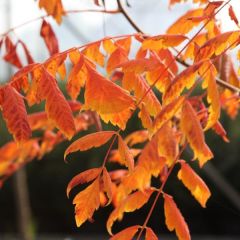
Koelreuteria paniculata Coral Sun
- Flowering time July, August
- Height at maturity 6 m
Discover other Koelreuteria - Golden Rain Tree
View all →Available in 2 sizes

Available in 2 sizes
Planting
Where to plant the Pride of India?
Although hardy down to -15°C, in regions with long winters or windy conditions, provide it with a well-sheltered spot from cold winds as late frosts can damage its flowering. It is advisable to protect young specimens from the cold. This tree does not like wind or sea spray. Native to dry areas, it will thrive in Mediterranean regions with hot summers as it tolerates drought well.
The Koelreuteria paniculata enjoys a sunny exposure, although it can tolerate partial shade. It grows in any well-drained soil, even dry, very porous, and calcareous. However, it will not tolerate clayey, waterlogged, or acidic soils.
Its modest dimensions and moderate growth make it an excellent choice for small gardens, whether in borders, as a specimen, or in alignment. In a city garden, prefer the Koelreuteria paniculata ‘Fastigiata’ or the Koelreuteria paniculata ‘Beachmaster’, which are less bulky varieties with a narrower and more compact habit than the species type.
When to plant?
The planting of the Pride of India is ideally done in spring, from March to May in colder regions or from September to November in other areas to encourage rooting before winter, avoiding frost periods.
How to plant the Pride of India?
Ensure it has enough space, at least 5 m between its base and another tree, wall, or fence.
- Dig a wide hole at least three times the volume of the root ball
- Spread a thick layer of gravel to aid drainage
- Enrich the soil with well-decomposed compost or two shovelfuls of potting soil
- Plant your Pride of India without burying the collar
- Keep the tree upright and stake if necessary
- Firm the soil and water generously until it is established
- Mulch the soil
To successfully plant your tree, check out our video!
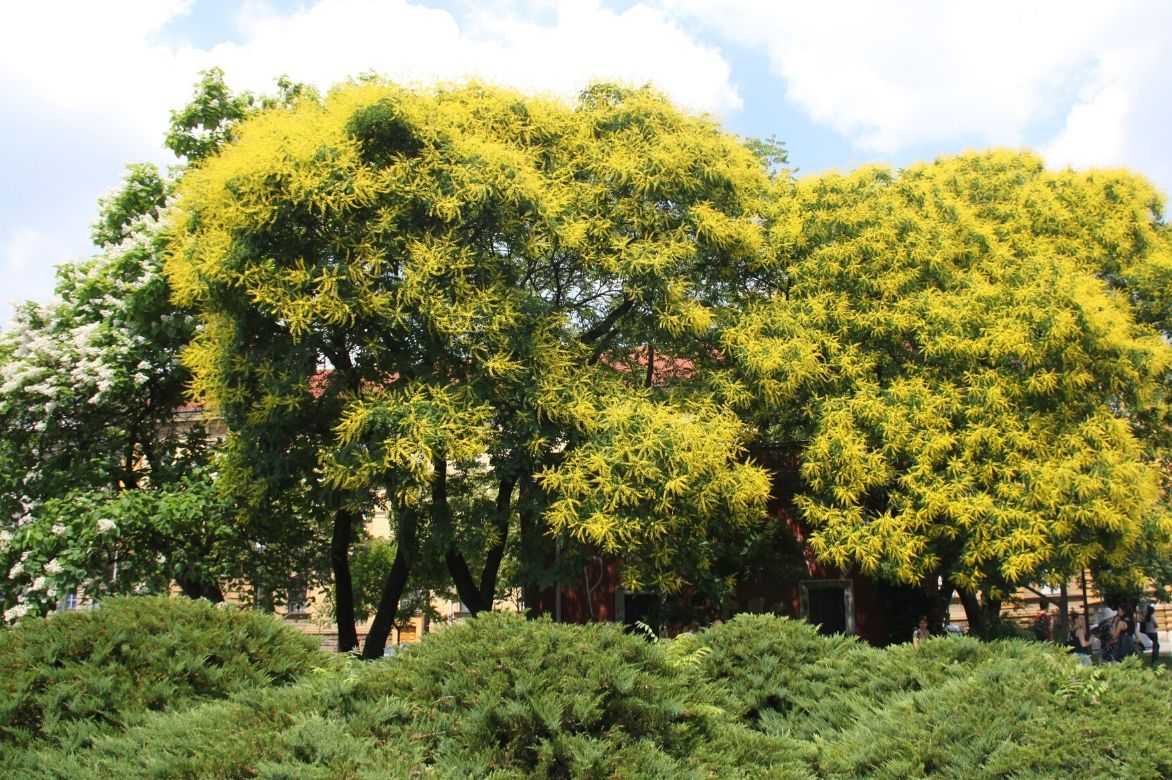 The Pride of India is a remarkable tree with beautiful sun-coloured flowers!</caption]
The Pride of India is a remarkable tree with beautiful sun-coloured flowers!</caption]
Maintenance, pruning and care
The Koelreuteria paniculata requires very little maintenance once well established.
In summer, monitor its water needs during the first two years to ensure successful establishment. After that, it will withstand drought very well; however, spread a good layer of organic mulch to keep the soil consistently cool and limit evaporation.
Once a year in autumn, fertilise the soil with a good organic fertiliser to promote its growth.
The Pride of India does not appreciate frequent or severe pruning, which can cause wounds that allow pathogenous fungi to enter and lead to wood rot: only prune if necessary at the end of winter, solely to remove dead wood, dried or damaged shoots, or in the case of broken or weak branches.
When planted in suitable growing conditions, the Pride of India proves resistant to most diseases as well as pest attacks.
Multiplication
Pride of India multiplies very easily by spontaneous sowing. Sowing after stratification, in autumn or early spring, is quite easy but patience is required, as the growth of the tree is rather slow. Layering, propagation by cuttings of semi-woody stems, and root cuttings at the end of winter are also possible. We recommend purchasing another Pride of India from our nursery.
Pairing ideas
The Pride of India is a small tree that generally thrives on its own and will add an exotic touch as punctuation in the middle of a lawn or a flowerbed in a small garden.
In spring, surround it with a carpet of bulbous plants such as the generously flowering ‘Darwin’ hybrid tulips, botanical tulips, daffodils, hyacinths, or even anemones coronaria.
The violet inflorescences of Whorled Sage ‘Purple Rain’ will provide an interesting contrast to the yellow flowering of the Pride of India. Accompany them with lovely umbels of fennel and Echinaceas in orange tones. Finally, extend the season by adding some clumps of grasses like Molinies that will dance in the wind, while the ‘Coral Sun’ Pride of India will see its foliage blaze in autumn.
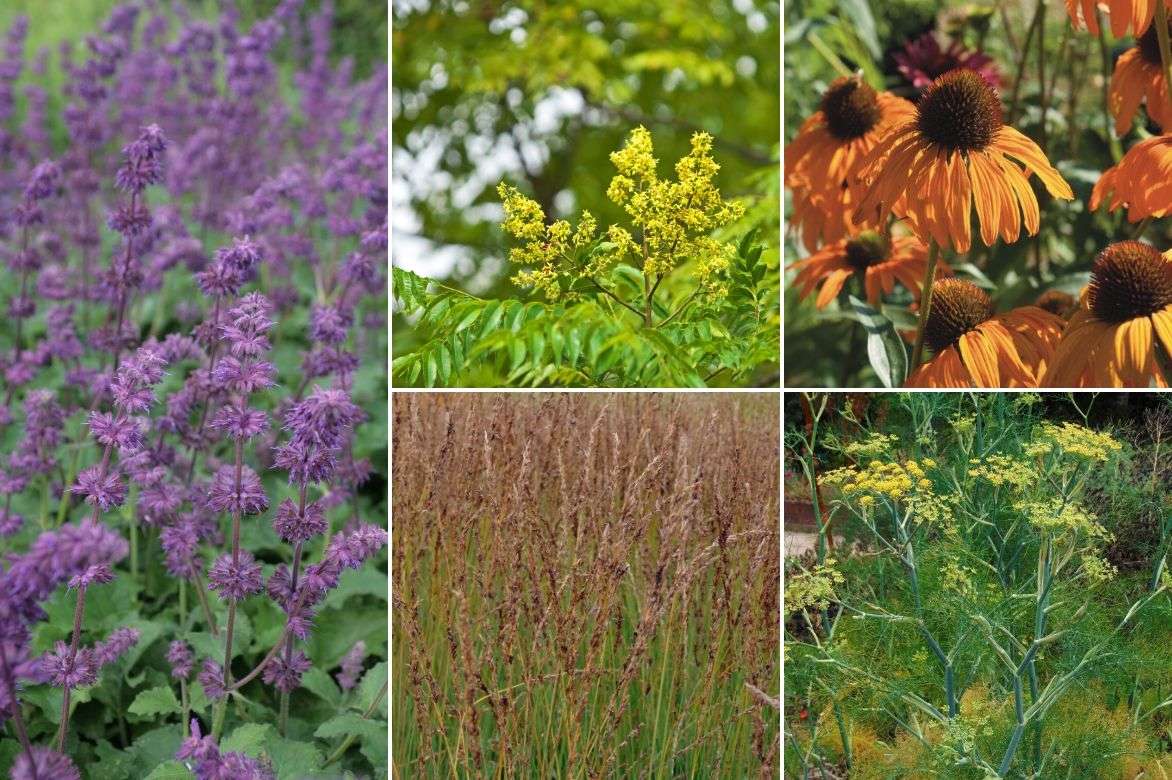
An example of a summer association: Salvia verticillata ‘Purple Rain’, Foeniculum vulgare, Echinacea ‘Tangerine Dream’, Molinia caerulea ‘Moorhexe’ with a backdrop of a Koelreuteria paniculata (‘Coral Sun’ for example, with absolutely remarkable foliage in autumn)
For more tangy harmonies, plant yellow-flowering shrubs such as Buddleja weyeriana ‘Sungold’, shrubby potentillas, Hypericum ‘Golden Beacon®’, or even perennials like Achillea filipendulina ‘Cloth of Gold’ nearby.
At the end of the season, the presence of a Sweet Gum (Cercidiphyllum japonicum), a Cornus sanguinea ‘Magic Flame’ or a Persian Parrotia alongside will literally set the garden on fire with their foliage in vibrant hues.
It will add a decorative aspect with its orange fruits, which persist throughout winter and can accompany the Sea Buckthorn ‘Friesdorfer Orange’ (Hippophae rhamnoides) or Euonymus planipes, a shrubby spindle.
Useful resources
- You have a small garden but wish to plant a tree: discover our selection of trees for small gardens!
- Everything you need to know about trees is on our blog!
- Discover our collection of summer-flowering bushes that could accompany your Pride of India.
- Learn more about unusual fruits in our article.
- Subscribe!
- Contents
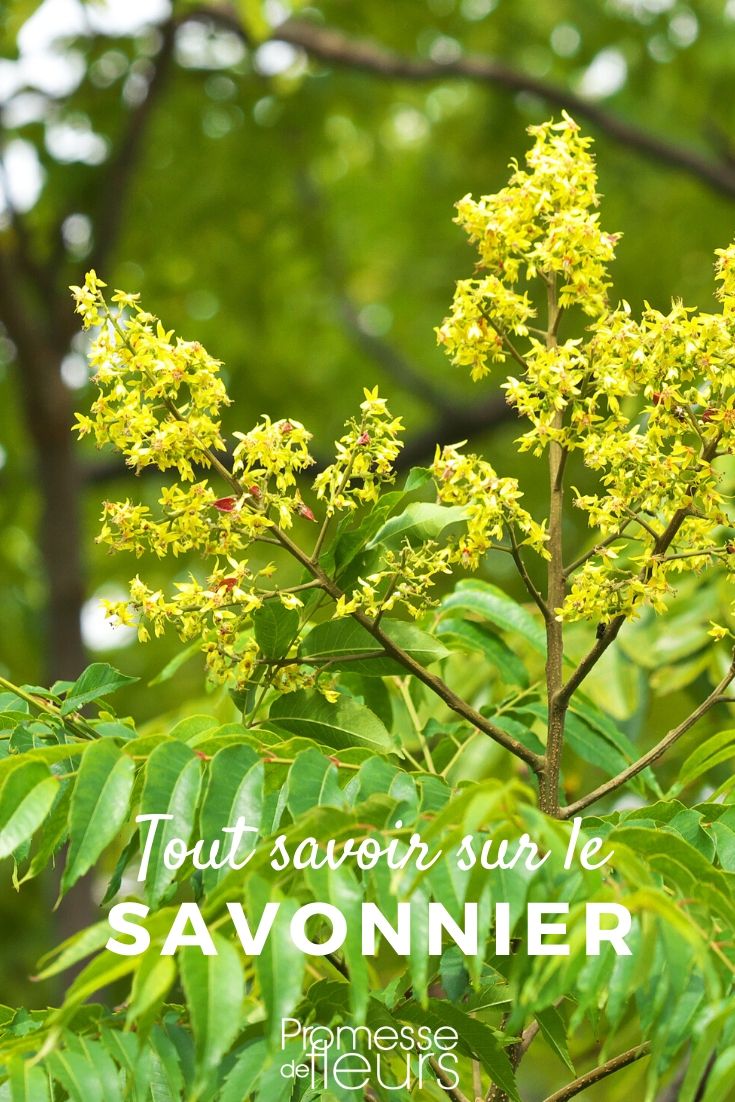































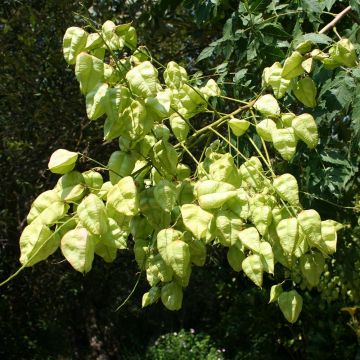
Comments